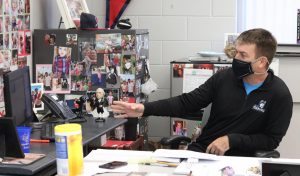Seminole Disconnected
Students deal with the ups and downs of virtual learning
September 1, 2020
The beginning of a new school year is always a challenging endeavor for students and teachers. Coupled with a raging pandemic, this year brought many unexpected surprises. While face-to-face kids dealt with white desk dividers and face masks, students who chose to learn virtually through Seminole Connect are experiencing their own issues and glitches through WebEx, Seminole County’s virtual teaching and video conferencing platform.
Not even two minutes into the first period, students were worried about their decision to do school virtually. Not only were they cut off from their peers, but as soon as class began students experienced audio feedback and muffled voices. No one could hear anything the teacher or the students in class were saying because their voices were incoherent over the webcam. Even now the problem is not totally fixed.
“If the teacher isn’t standing near the computer we can’t hear anything she is saying, or the class either.” said sophomore Hallie Yonker, a full-time Seminole Connect student. “Especially in my physics class, where she lectures the whole time. It’s hard to keep up.”
While the school is working to provide teachers with headsets so students can hear better, that may not fix the problem with class communication as a whole. Even with the microphone, no one over Seminole Connect is able to hear anyone but the teacher. There is a chat box, junior Andrew Huddleston, a full-time Seminole Connect student, explains that it can be “hard to articulate things through the chat.”
“As soon as I type out my answer, the conversation has already shifted to something else and the whole class has moved on,” Huddleson said.
Not only are class discussions made difficult because it is hard to hear in-class banter over the faulty microphones, it is further limited because some teachers tend to check the chat sporadically.
“Most of my teachers either ignore us if they have face-to-face students, or just never check the chat,” Yonker said.
The situation is circumstantial, and the need for constant teacher presence depends on the type of class. Senior Emily Taylor, a full time Seminole Connect student, takes a variety of classes, yet only finds certain ones constitute attention.
“Teachers checking the chat is not really a huge issue for me. It only really gets difficult in classes like math or forensics because there is less participation and the teacher is usually teaching a lesson rather than having class discussion,” Taylor said.
Social media programs such as Snapchat and Instagram have become quite useful as a way to combat miscommunications or confusion. Students have made group chats and connections to relay information back and forth to each other.
Questions arose as to how the school district would handle things such as increased risk of cheating, and teachers are evaluating different options. Easy access to the internet and unsupervised test-taking is the major concern for teachers. One feature on eCampus allows teachers to monitor the test taking process online, and they are able to see if the student clicked onto another tab, and for how long. Likewise, most assignments that are submitted online are put through a plagiarism checking website called Turnitin.
While teachers worry about the potential of cheating in Seminole Connect, the students were more concerned with the social aspect of virtual school. SCPS has made an immense effort to make the school transition as safe as possible, and a big selling point to returning to “regular” teaching in person was that people would finally be able to see their friends again, and interact in a learning community once more.
Not all have opted to venture out of their quarantine caves, choosing instead to stay perpetually in pajamas and listening to the Mama Mia soundtrack on repeat. Virtual students, such as Yonker, feel dejected at the fact that they can’t see their friends as often as they’d like.
Although staff and students have run into some roadblocks, Seminole Connect students still find many positive attributes, and these challenges are dissipating as the days progress. Students can wake up at 8 o’clock, eat Doritos during class, and leave class early. Not only this, but online learning comes naturally to people like junior Kat Bell, a full-online student.
“After my last class I don’t even feel the need to stop, I just keep going and doing work. Having to stop the train of thought and drive home interrupts my process, so it’s easier for me to just work online,” Bell said.
Now that teachers have switched to a mostly online class without paper and all online turning in, students have noticed that this is an asset, and that it is “easier to plan out the week,” Taylor said.
Senior Sacha Gilbert also looks on the bright side of her situation as a hybrid student, admiring that fact that it is easier for her to stay on pace and speak-up in class discussions.
“It’s a lot simpler for me to ask questions because I don’t speak out that much in person, so when I have a question it’s easier to type it, knowing the teacher will eventually see it,” Gilbert said.
Those students enlisted in Seminole Connect can reevaluate their decision at the end of this quarter, or after the first 9 weeks. They can either stay home with Netflix and Webex, or they can choose to return to campus with a mask in one hand and a “stay six-feet away from me” sign in the other.

